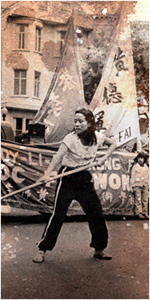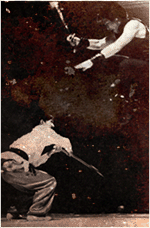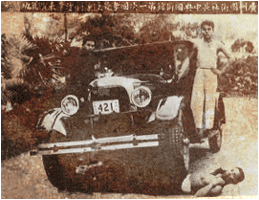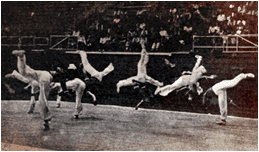 |

The
Chinese Government still promotes the arts for health to this day.
|
The
history of Ba Gua Zhang, and most other Chinese martial arts as well, is such
that today it is very difficult for anyone interested in studying these arts
to again exposure to a complete system By complete system I am referring to
a comprehensive step-by-step method of training which is designed to develop
a high level of well-rounded martial arts skill. While all traditional martial
arts styles started out as complete systems, over the years these systems have
been whittled away until all that we are left with today, in many cases, are
fragments. In some cases all that is left of a particular system is one form
sequence. If we look at the history of China in relation to the martial arts,
it is not difficult to understand how the fragmentation occurred.
Since the end of the Qing Dynasty martial arts instruction and practice in Mainland
China has undergone a slow transformation from being studied solely for use
in defense of one's self and others to being practiced predominantly for health
and/or performance. This transformation began to take place during the early
years of the Republic when prominent Government officials and skilled martial
artists developed public martial arts programs for the purpose of improving
the physical fitness of the Chinese people. The Central Martial Arts Academy
(Zhong Yang Guo Shu Guan), which was opened in the late 1920's in Nanjing, and
its network of subsidiary provincial martial arts schools, was an outgrowth
of this program. The transformation further progressed under the communist government
who will promote a diluted version of the health and performance style martial
arts and has sought to standardize the martial arts by reducing complete systems
of training down to a handful of performance oriented forms.
|
Marital Arts for Health
After the overthrow of the Qing Government in 1911, the "martial arts for health"
movement began to emerge in China for two reasons. First, the Chinese people were
generally weak. A corrupt government, foreign invasion, opium addiction, and poor
harvest had beaten the people down. Second, for the same reasons listed above,
national pride was low. The new government decided that in order to strengthen
the country, they needed to strengthen the people. In order to strengthen the
people, and increase national pride, they chose to use traditional Chinese methods
of physical training, which meant using the Chinese martial arts. Influential
intellectual martial artists, like Sun Lu Tang, helped begin this movement. Sun
Lu Tang's introduction to his book on Xing Yi Quan (Xing Yi Quan Xue - published
in 1915) states, "the way of becoming prosperous and strong lies in the bracing
up of the people. The important point is to brace up the spirit. A strong country
cannot be composed of weak people. We cannot make people strong without physical
training. To brace up the people through physical training is the way to strengthen
the country."
Other traditional martial artists began to echo Sun's words. They even began calling
the martial arts the "national arts" or guo shu to distinguish them from Western
sports activities and promote a sense of national pride. |

Wushu - China's performance arts. Martial beauty without
the fighting.
|
As
time went on and China was plagued with Japanese imperialism and further Western
modernization, the guo shu movement became stronger and plans were made for a
national guo shu program. The principal of the Central Martial Arts Academy in
Nanjing (Zhong Yang Guo Shu Guan), Zhang Zhi Jiang, proclaimed, "strengthening
oneself strengthens the race and protecting oneself protects the country."
The Central Martial Arts Academy was officially opened in December of 1927 and
by March 1928 they had acquired sufficient funds to get the school off its feet.
Their goal was to train a crop of instructors who would spread martial arts training
throughout China in public schools in order to "make martial arts common in all
walks of life." However, as traditional martial arts were exposed to a wider variety
of people, the traditional instruction was greatly modified for mass consumption.
|

The public view of martial artists are often reduced to
acts of amazing human feats such as this.
|
In
the late 1800's and the early years of this century, those that studied martial
arts in China were primarily farmers and peasants who hoped to obtain jobs as
bodyguards, caravan escorts and residence guards. Since police protection did
not exist outside of the major cities, men in small villages also trained in
martial arts in order to protect their homes from bandits and thieves. The majority
of these individuals were uneducated and were considered to be "ruffians" by
the educated class in China. Sun Lu Tan's introduction to his book on Xing Yi
Quan say, "There was a prejudice in the old days that literates despised martial
arts as martial artists were short on literary learning."
|
However,
he also indicated that the times were changing. He continues by saying, "Now the
country will be improved through reforming affairs. Martial arts has been put
into the curriculum in schools so that students can be cherished on both literary
and military sites. This is a good way."
While the student was studying the fundamentals of the art, the teacher also tested
the student's loyalty, patience, martial morality and determination. All of these
factors were weighed along with the student's physical ability when the teacher
made decisions about when the student would be exposed to new material. This training,
at all levels, was extremely difficult and the teacher placed high demands on
the students. Only the most loyal, hard working, and highest skilled students
would earn the right to become "inner door" students and lineage holders. It was
not uncommon for an instructor to only choose one student to receive the full
transmission of his art. In order to teach short "martial arts for health" courses
to the public something had to give. |
Traditional
martial arts instructors who participated in the national programs saw this as
an opportunity to gain some "face" for themselves and the martial arts, however,
they were not totally willing to let go of tradition. Traditional instruction
consisted of a student studying with one teacher for a significant amount of time
in a private or small group setting. The teacher usually taught at his home or
in a park near his home. Students were taught slowly and steadily with an emphasis
on basic training. Advance skills were only taught after fundamental skills could
be performed with a sufficient degree of expertise.
|
 Wushu exhibit
Wushu exhibit
|
What
occurred in the public classes was that the students were taught a very small
slice of the complete martial art. The forms and exercises that were taught were
traditional, however, typically the teachers only taught a few basic exercises
and forms which were good for developing general balance, coordination, and flexibility.
Since health became the emphasis, the very rigorous training which was designed
to teach students how to fully develop into good fighters was not generally taught.
Of course, if the student in the public class showed great potential a teacher
would take that student aside and teach that student privately and possibly give
that student the complete transmission of the art, but these cases were rare.
Most of the individuals in the public classes only received the surface level
of the art they were studying.
Originally published in the Pa Kua Chang Journal - July/Aug
94
Used with permission.
|
|
|
|
